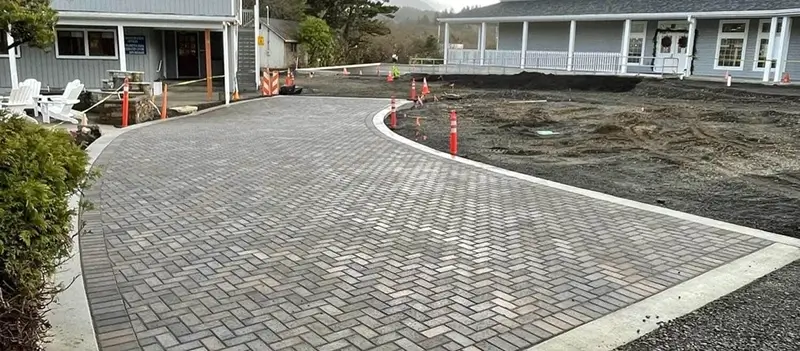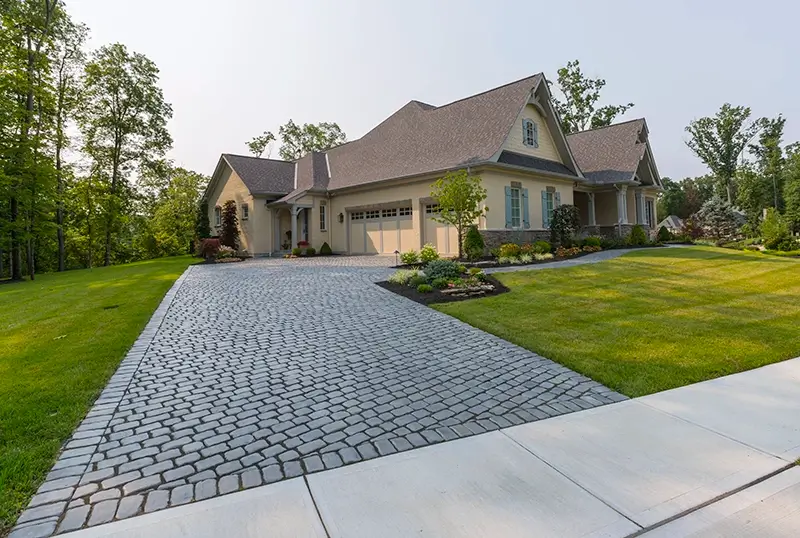CALL US FREE ESTIMATE
CALL US FREE ESTIMATE

Sustainable urban development has emerged as a paramount goal in addressing the environmental challenges faced by rapidly growing cities worldwide. As urban populations swell, the demand for well-designed infrastructure becomes increasingly pressing. Among the critical components of urban infrastructure, pavements are pivotal in connecting communities, facilitating transportation, and shaping the overall urban landscape. In recent years, the focus on sustainability has extended to the realm of pavement design, seeking solutions that harmonize the needs of urban development with environmental responsibility.
This article explores the significant role that pavement design plays in fostering sustainable urban development. Let’s embark on this journey to explore the transformative potential of sustainable pavement design in shaping our urban landscapes.
Conventional pavements, primarily asphalt and concrete, have been the go-to choice for urban development and transportation infrastructure for decades. In contrast, these materials offer durability and functionality but have significant environmental consequences. Understanding the environmental impact of conventional pavements is essential in recognizing the urgent need for more sustainable alternatives. The key environmental concerns associated with conventional pavements are as follows.
The production of asphalt and concrete requires vast amounts of natural resources. Asphalt is derived from petroleum, a non-renewable fossil fuel, while concrete relies on sand, gravel, and limestone extraction. The continuous demand for these finite resources can lead to environmental degradation and habitat destruction.
The production of conventional pavement materials involves energy-intensive processes, leading to substantial greenhouse gas emissions. Carbon dioxide (CO2) and other greenhouse gases released during material extraction, transportation, and production contribute to climate change, exacerbating global warming and its associated impacts.
Conventional pavements absorb and retain heat, contributing to the urban heat island effect. As cities become more densely developed, the excessive heat generated by pavements can raise local temperatures, affecting the microclimate and exacerbating energy consumption for cooling.
Impermeable surfaces like traditional asphalt and concrete hinder natural water infiltration. As a result, rainwater cannot replenish aquifers, leading to increased stormwater runoff. This runoff picks up pollutants, such as oil, heavy metals, and chemicals, from the pavement surface, contaminating water bodies and posing a threat to aquatic ecosystems.

Embracing sustainable pavement materials is a crucial step towards mitigating the environmental impact of urban development and creating more eco-friendly and resilient infrastructure.
Porous pavements allow water infiltration through the pavement surface and into the underlying soil. They consist of permeable materials and a stone bed that promotes water drainage and filtration. Porous pavements help manage stormwater runoff, reduce flooding, and recharge groundwater, thereby mitigating the adverse effects of urbanization on water resources.
Rubberized asphalt incorporates recycled rubber from discarded tires into the pavement mix. This sustainable material reuses a significant waste stream and improves pavement flexibility, reducing cracking and increasing the pavement's longevity. It also provides better skid resistance and noise reduction, enhancing safety and comfort for road users.
Green permeable pavements combine vegetation with permeable materials, allowing water to pass through the pavement and supporting the growth of plants. This innovative approach manages stormwater, contributes to urban biodiversity, enhances air quality, and reduces urban heat island effects. Green permeable pavements create aesthetically pleasing and environmentally friendly urban spaces.

Balancing aesthetics and sustainability in pavement design is critical for creating visually appealing and environmentally friendly urban landscapes. While sustainability minimizes environmental impact and resource use, aesthetics significantly shape a city's look and feel. Striking the right balance between these two aspects can lead to more vibrant and socially cohesive urban spaces. Here are some key factors to consider when harmonizing aesthetics and sustainability in pavement design.
Choosing sustainable pavement materials that also offer a pleasing appearance is essential. Integrating recycled aggregates, bio-based binders, or rubberized asphalt can provide eco-friendly options without compromising aesthetics. Moreover, exploring innovative surface finishes and colors can add visual interest to pavements, enhancing their appeal.
Pavement design should be contextually sensitive to the surrounding environment and architectural style. Incorporating materials and patterns that complement nearby buildings and natural surroundings can create a harmonious urban landscape. For instance, using natural stone in historical areas or vibrant colored pavements in creative districts can reflect the local character.
Integrating green spaces and landscaping elements within pavement design can enhance aesthetics and sustainability. Planting trees, shrubs, and flowers along pavements adds beauty, improves air quality, provides shade, and promotes biodiversity.
Involving the community in pavement design decisions fosters a sense of ownership and pride. Conducting public consultations and workshops to gather input on design preferences can lead to pavements that resonate with the local population while aligning with sustainability goals.
Infusing artistic elements and public installations into pavement design can elevate aesthetics and create landmarks that draw people together. Integrating sculptures, mosaics, or other artistic interventions can transform pavements into engaging public spaces.
Utilizing permeable and pervious pavements allows water infiltration while maintaining aesthetic appeal. Integrating decorative aggregates or colored permeable pavers can create visually attractive pavements that effectively manage stormwater.
Thoughtful lighting design can enhance the aesthetics of pavements during nighttime while ensuring safety and wayfinding for pedestrians. Using energy-efficient lighting and creative designs can minimize light pollution and create inviting nighttime environments.

Sustainable pavements should be designed with durability and low maintenance in mind. Implementing durable materials and construction practices reduces the need for frequent repairs and replacements, contributing to the long-term aesthetic appeal of pavements.
Sustainable pavement design fosters environmentally responsible and visually appealing urban development. Striking a balance between aesthetics and sustainability requires collaboration, public engagement, and forward-thinking policies. By involving the community in pavement design decisions, integrating art and public installations, and considering contextual integration, we can create pavements that resonate with residents while promoting ecological balance.
Join Stenco Constructions in our journey toward sustainable urban development. Whether you are a city planner, developer, or stakeholder in infrastructure projects, you can make a difference by choosing sustainable pavement solutions that prioritize the environment without compromising aesthetics. Let us collaborate to create urban spaces that delight the eye and contribute to a healthier planet.
No matter what type of project you have, we can help